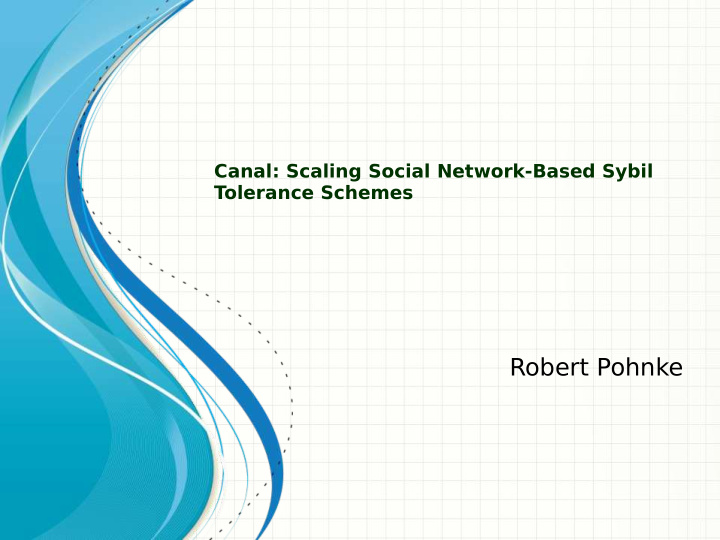



Canal: Scaling Social Network-Based Sybil Tolerance Schemes Robert Pohnke
Plan 1. Problem Description 2. Canal mechanism 3. Results 4. Q&A
Reputation systems • A reputation system computes and publishes reputation scores for a set of objects (e.g. service providers, services, goods or entities) within a community or domain, based on a collection of opinions that other entities hold about the objects.
Reputation systems • Many different variations: recommender systems, collaborative filtering, voting systems • Examples: eBay, PageRank, YouT ube, Digg, CoachSurfing • But also social media – Facebook, LinkedIn
Sybil attacks • Multiple pseudonymous identities forged by a malicious user (or a group) • Used to gain unfair advantage over honest users • Possible effects: content manipulation, SPAM, fraud transactions, …
Defense mechanisms: • Sybil prevention – preventing the attacker from creating Sybil identities (CAPCHA, Document Verification) • Sybil detection – detecting and removing fake identities; • Sybil tolerance – designed to limit the impact that a malicious user can have on others
Detection vs. T olerance • Although an attacker can create an arbitrary number of Sybil identities in the social network, she cannot establish an arbitrary number of social connections to non-Sybil identities. • The non-Sybil region of the network is densely connected, meaning random walks in the non- Sybil region quickly reach a stationary distribution
Ostra • Ostra is targeted at countering unwanted communication (i.e., SPAM). Ostra assumes the existence of a social network, and assigns credit values to the links. When a user wishes to send a message to another user, Ostra locates a path with available credit from the source to the destination.
SumUp • SumUp is designed to prevent users with multiple identities from manipulating object ratings in content sharing systems like Digg. SumUp assumes the existence of a social network and selects a trusted vote collector.
Bazaar • Bazaar provides stronger user reputations in online marketplaces like eBay. T o do so, Bazaar creates a transaction network by linking pairs of identities that have successfully completed a transaction; the weight of each link is the dollar value of the transaction. • When a new transaction is about to take place, Bazaar compares the value of the new transaction to the max flow between the buyer and seller.
Credit network • Most popular approach to sybil tolerance • Based on trust: each user assigns amount of trust to other users, typically credits. • Every action (i.e. sending a message) has a cost. The action is allowed if a path from A to B exists with enough credits to cover the action cost. • If the action is not reported as a fraud, the credit is refunded
Why does it work? • Based on the second assumption:
Problem? • The most efficient algorithms for the maximum flow problem run in O(V3) or O(V2 log(E)) • The network is dynamic, credit values change rapidly
Canal Canal is extending the concept of credit networks. It trades off accuracy for speed. It is designed to run alongside an existing Sybil tolerance scheme, providing two services: • maintaining the state of the credit network , • conducting credit payments.
Landmark routing Simple idea – instead of computing max flow to all users, lets compute the distance to a landmark and stitch a path from A to B via landmark. Note that credit transfer does not require the path to be the shortest one – we are only interested if it exists.
Landmark Universe • Lets define k-Universe as a network with k levels of landmarks, each of them consisting of 2k elements: 20, 21, 22, … , 2k (2k+1 -1 in total) • Every user computes the path to the nearest landmark on each level. Every pair of users is bound to have at least one common landmark.
Landmark Universe
Universe Creator 1. Randomly select k random node sets of the appropriate sizes from the network. Let the selected sets be denoted by V0, V1, V2, ... Vk. These sets contain the new landmarks at each level. 2. For each set Vi, and every node u ∈ V , calculate the shortest path from u to each of the landmark nodes in each set Vi. This is done by having the processes perform BFSs from each landmark in Vi. 3. Finally, using the BFSs, construct the landmark map for level Vi by select the closest landmark node in Vi and the next hop for all nodes.
Path stitcher 1. Scan the k landmark maps and collect the set of common landmarks between a and b . 2. For each shared landmark, use the next hop in the landmark map to “stitch” together a path via the landmark. 3. Refine the path by eliminating any cycles and performing path short- cutting. T o perform short-cutting, we traverse the path up to the landmark node and see if there is a link from any of these nodes to a node lying in the path after the landmark node. If so, we short-circuit the path by using that link to create a shorter path between a and b .
Updating paths • The path stitcher process pays as much credit as possible along each path. For each path, the path stitcher process walks the path, obtaining the lock on each link of the path, temporarily lowering the credit available to 0, and then releasing the lock. • Once the end of the path has been reached, the path stitcher calculates the maximum credit available on the entire path. Next, the appropriate values are restored on the whole path.
Results
Results
Results
Results
Thank you for your attention Questions?
Recommend
More recommend